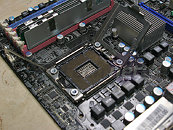Monday, August 18th 2008

Common LGA-1366 Cooling Myths Busted
With the entry of the Core i7 Bloomfield series processors this September thru October, the computing world will witness the entry of a new motherboard processor socket, the 1366-pin Land Grid Array (LGA-1366). FrostyTech demystified the new socket in respect to the way coolers are to be designed to be compatible with it, which will have implications on a vast segment of DIY consumers since LGA-1366 is meant to be a high-performance flagship computing platform. There are two key factors at play:
Speaking of the cooler retention mechanism, some coolers could use spring-tensioned machine screws to attach the heatsink to a metal backing plate. Intel's stock cooler is found to use standard through-PCB plastic push-pin mounting brackets. There won't be a retention cage (of the sort found on the older Socket 478 motherboards).
Sources:
FrostyTech, Bit-Tech.net
- The layout and cooler-retention mechanism of the socket
- The area of contact between the cooler and the processor's integrated heatspreader (IHS).
Speaking of the cooler retention mechanism, some coolers could use spring-tensioned machine screws to attach the heatsink to a metal backing plate. Intel's stock cooler is found to use standard through-PCB plastic push-pin mounting brackets. There won't be a retention cage (of the sort found on the older Socket 478 motherboards).

36 Comments on Common LGA-1366 Cooling Myths Busted
^Does that still look square to you?
and copied stuff from ibm, and amd is using SSE, 86 from intel
take em to school
intel needed a second source for the 8086 or IBM wouldn't use Intel chips, Intel Licensed 8086 to AMD. Same for 286 AMD was made second source for the chips. Then came 386 and AMD didn't have a second source contract but they built the 386 anyway which got them sued but there contract with Intel from the 286 still allowed them to use the 386. The am486 is a reverse engineered i486. It was after this they split apart. The K5 was a glorifed am486 in reality with an extra pipeline added to make it super scaler and 64bit addressing was added. The K6 was based on RISC with an x86 backend. The K7 and up are the same way, RISC based with x86 translation backends. AMD got the rights to x86 when they got the 8086 license back in 1980. Intel made an agreement with AMD in 2001 to share license techs with each other. AMD got SSE for the palamino with that deal. Intel got x64 instruction set in 2002 when AMD showed off the opteron. AMD got SSE2 and 3 through the same agreement. They cross license because it helps them both out. Intel would have had to make sevral techs on there own with out AMD and vice versa.